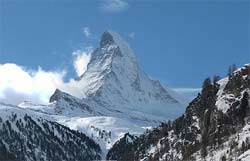Climate change forces Italy-Switzerland to redraw border
27 Mar 2009
Melting of the Alpine glaciers near the Matterhorn of the Italy-Switzerland border due to climate change, is forcing both countries to redraw their 148-year old border.
The glaciers in the Alps served as a guideline to define the Swiss-Italy border when it was drawn up during the Italian monarchy in 1861, but climate change is forcing both the countries to redraw new frontiers in a peaceful manner.
 The borders pass through the ''cryosphere'', where the glaciers are located and it is these very glaciers, covered with snow and permafrost, have started melting due to rise in temperatures since the past 20 years, changing the landscape.
The borders pass through the ''cryosphere'', where the glaciers are located and it is these very glaciers, covered with snow and permafrost, have started melting due to rise in temperatures since the past 20 years, changing the landscape.
Scientists from both countries say that since the past five years, the melting of the Alpine glaciers has accelerated and the Italian Military Geographic Institute has blamed climate change for this meltdown.
Since the border may have to be shifted at the most by a hundred metres, the towns near the mountains like the Cervina in the Aosta Valley will not be affected, since the border demarcating the two countries lies more than 4,000 metres above sea level.
Switzerland does not need to change any law to redefine its border but Italy does. The Italian government has prepared a bill, which if passed by the parliament, will become a law so that Italy can also make the necessary changes.
According to Danish daily Berlingske, Italian MP Franco Narducci told the Italian news agency AdnKronos, "Once upon a time, the border line demarcation between two nations was synonymous to war and bloodshed but instead, today we proceed with photograms."
He also said that Italy is bringing a bill to be passed in parliament to revise and verify the borders out of necessity due to the changes in climate and atmosphere.
The hot summer of 2003 had created heat waves resulting in a lot of changes in the landscape leading to many landslides from the melting of the permafrost.
For the first time ever the zero-degree altitude went higher than 4,000 metres, and the morphology of many parts of the mountains began to change, said Luca Mercalli, a well-known Italian metereologist and climatologist.
Due to climate change, the reference points that used to demarcate the borders changed positions, although in places the conventional border followed water courses, but positions have changed significantly where glaciers have melted.
Although the border between Italy and Switzerland was demarcated in 1861, it has been occasionally changed and the last change took place in 1970 when an Italian-Swiss highway was built near a border crossing.
The areas affected are the mountains encircling the 4,478-metre-high Matterhorn, also called the Cervino in Italy. The towns near the Matterhorn are a popular destination for skiers and climbers who climb the Matterhorn from either Cervinia in Italy or Zermatt in Switzerland.
The Matterhorn in the Pennine Alps is 4,478 meters is one of the highest and most difficult to climb peaks in the Alps, which claimed the lives of over 500 mountaineers between 1865 and 1995.







.webp)














